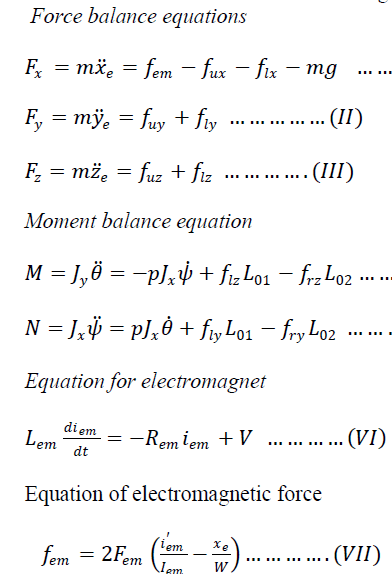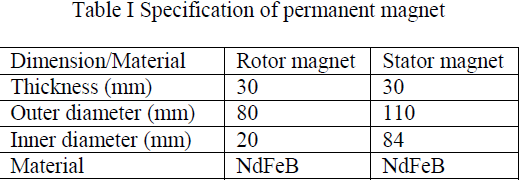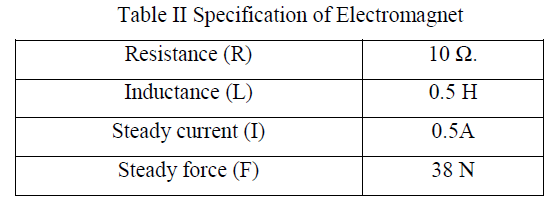ISSN ONLINE(2278-8875) PRINT (2320-3765)
ISSN ONLINE(2278-8875) PRINT (2320-3765)
Tapan Santra1, Dr. D. Roy2, A.B. Choudhury3
|
| Related article at Pubmed, Scholar Google |
Visit for more related articles at International Journal of Advanced Research in Electrical, Electronics and Instrumentation Engineering
Single axis controlled repulsive type magnetic bearing (SACRMB) is the most promising bearing due its low cost and simple construction. This bearing has low loss, low noise, no lubrication and no hazards. This paper introduces a vertical shaft SACRMB, consists of permanent magnets for radial stability and electromagnets for levitation & axial stability. SACRMB has tremendous opportunities to become a common choice for house hold to industrial applications. It has been investigated that though SACRMB has radial stability due to repulsive stabilization force by passive permanent magnets but this devise suffers from axial instability. In this paper a PID controller has been designed to make the system axially stable by controlling the current through an electromagnet. It is found that the radial & axial vibrations are under tolerable limit and SACRMB works extremely well.
Keywords |
| SACRMB, PID controller, magnetic forces, stability, vibration. |
INTRODUCTION |
| In recent century there is a tendency to investigate on the bearing which will be free from all the disadvantages like high noise, lubrication, maintenance, energy loss & hazards. So the magnetic baring comes into the picture, but most of the magnetic bearing is purely active or passive in nature [1, 2, 3, 4 & 5] and suffers due to its complex construction & control which makes it less reliable and costly. So we required a magnetic bearing which should have low cost, simple construction and high reliability. Single axis controlled repulsive type magnetic bearing (SACRMB) [6] is one probable solution in which the radial vibration is minimized by the repulsive stabilizing force between permanent magnets and axial vibration is controlled by the attractive force between a flywheel and an electromagnet through a controller. In this paper a PID controller [7] has been designed and tested. It has been observed that radial and axial vibration is under control and the SACRMB works very well. |
CONSTRUCTION OF SACRMB |
| Being a bearing SACRMB is to serve two basic purposes, supporting of the rotor and minimizing of vibration of the rotor system. Fig. 1 represents a SACRMB in vertical shaft configuration. In this construction two ring magnets are attached with the shaft. These ring magnets are called rotor magnet. These rotor magnets can rotate inside another two ring magnets, attached with the frame of the bearing. These two magnets are call ed stator magnet. These four magnets are of permanent type and their material is NdFeB. When the rotor vibrates along radial direction there is a change in repulsive force between rotor and stator magnet which will stabilize the rotor. At the same time there is a vertical component of this repulsive force which makes the rotor axially unstable. So how the axial stability can be achieved? A flywheel is attached with the shaft and above this flywheel an electromagnet is placed. The attractive force between this flywheel and electromagnet is utilized to make the rotor axially stable. A PID controller has been designed to control this attractive force by controlling the current through the electromagnet coil. Gap sensor is used to find out the change in axial gap and feedback it to the controller. |
 |
MODELLING OF SACRMB |
| The different forces acting on the rotor are shown in the Fig. 2. The rotor is considered as rigid body. The origin G is the stator fixed frame of reference, O is the mass centre of the rotor and (xe, ye, ze) is the location of O with respect to fixed frame of reference. The force and moment balance around & and force of electromagnets are given by equations (I) to (VII). |
 |
 |
 |
| current & gap between electromagnet & flywheel at steady operating condition respectively. ′ is the instantaneous change in coil current respectively. |
 |
 |
 |
 |
 |
PARAMETER OF SACRMB |
| Before going for the simulation, the parameter value of SACRMB must be assigned. These parameters are for permanent magnet, electromagnet, rotor system & gap sensor. All the parameters value are shown in Table II to table V |
 |
 |
 |
PID CONTROLLER DESIGN |
| Now modelling is over, parameters are fixed, we can go for the vibration characteristics. Fig. 6 shows the open loop step response for axial vibration of SACRMB, which is unbounded in nature. This means the SACRMB is axially unstable. Fig. 7 & Fig. 8 shows the radial vibration characteristics ( Force in N Vs Displacement in mm) |
 |
| along Y & Z axis respectively. It is observed that the radial vibration are under 0.02 mm and can be excepted fairly. Only noticible thing is that the rotor will continue to rotate, shifted slightly along positive Z axis. |
 |
| As the SACRMB is axially unstable, a PID controller has been designed and implemented as per the Fig. 9 and corresponding axial vibration is observed in Fig.10. The change in axial displacement is minimized and vibration is controlled perfectly. |
 |
CONCLUSION |
| In this paper construction, modelling and controller design of a vertical shaft single axis controlled repulsive type magnetic bearing has been implemented. SACRMB has huge probability to become a key player in the bearing market within the next few years due to its advantageous position over existing mechanical bearing. The radial vibration is controlled by passive permanent magnets. The strength and dimension of these magnets are the main constraints of SACRMB design. But now a day’s NdFeB magnets can remove these problems. In this paper the axial vibration is controlled by controlling the current of an electromagnet by a PID controller and the axial vibration is observed to be under limit and well accepted. |
References |
|